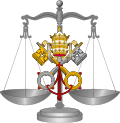Each of these human acts requires the development of mind, body, or spirit appropriate to its free and voluntary acceptance and adequate knowledge of, and capability for, the duties and obligations attached. The ages prescribed by canon law differ, as do the privileges, offices, and dignities to which they apply. [16]
Priesthood, orders, and clerical office
The ancient discipline was neither universal nor fixed but varied with circumstances of time and locality. The requisite age, according to Gratian, for tonsure and the first three minor orders, those of doorkeeper, reader, and exorcist, was seven, and for acolyte, twelve years. [16]
The Council of Trent fixed the ages of 21 years and 1 day for subdeaconship, 22 years and 1 day for deaconship, and 24 years and 1 day for priesthood. Canon 1031 CIC fixed the ages of 23 for deaconship and 25 for priesthood. The first day of the year the canonical age is to be reached is sufficiently timely for the reception of the order. Trent confirmed the Lateran age of thirty years for the episcopate. The 1983 Code of Canon Law estimates the general age for a permanent deacon as thirty-five years. A candidate for the permanent diaconate who is not married is not to be admitted to the diaconate until after completing at least the twenty-fifth year of age; one who is married, not until after completing at least the thirty-fifth year of age. [19]
For admission to the canonical novitiate, an age of 17 years is fixed by Canon law (can. 643); for admission to the solemn vows (and analogously to the Consecration of virgins), it is 21 (can. 658).
Generals, provincials, abbots, and other regular prelates having quasi-episcopal jurisdiction must, according to many constitutions, have completed their thirtieth year before an election; according to others, their 25th year. However, various orders and congregations have rules for the requisite ages for inferior offices and dignities.
The Council of Trent (Sess. xxv, cap. 7, de regular. et monial.) fixed forty years, and eight years after her solemn vows, for an abbess, mother general, or prioress of a religious order. If a convent (monastery) had no nun or religious sister meeting those requirements, then one over thirty years old and more than five years professed can be elected. An election contrary to these rules is invalid.
